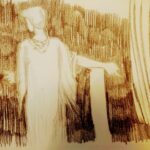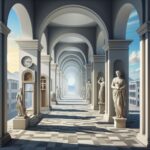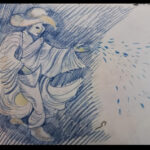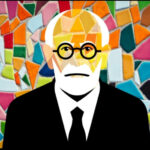Giorgio de Chirico’s art is a profound narrative that leverages the uncanny and the architectural to craft scenes that exist beyond the typical bounds of reality, embodying the core of the Metaphysical art movement. His works, characterized by their dreamlike aura and enigmatic quality, not only influenced generations of artists but also invite deep psychoanalytical interpretations that align closely with contemporary studies in dream psychology and the philosophy of mind.
Analysis of Key Works
The Melancholy and Mystery of a Street (1914)
This painting is a quintessential example of de Chirico’s style, where the sharp contrast between the vivid, stark sunlight and the elongated shadows creates a jarring visual. The depiction of the empty arcades and the small, distant figure of a child evokes a sense of vulnerability and existential dread. The spatial arrangement in the painting can be seen as a representation of the Jungian archetype of the ‘shadow’ – the unacknowledged part of the self, projecting isolation and the subconscious fears of the viewer.
The Enigma of an Autumn Afternoon (1910)
As one of the pioneers of the Metaphysical art movement, this work uses the deserted piazza to symbolize the vastness of the unconscious mind. The faceless figures suggest the depersonalization one might experience in dreams, serving as placeholders for any and every identity. This anonymity can be interpreted through Freud’s theory of the ‘uncanny,’ which posits that familiar objects can become profoundly disorienting and strange under certain conditions.
The Soothsayer’s Recompense (1913)
This composition is a complex amalgamation of symbols—each potentially a fragment of the unconscious. The classical bust and the factory smokestacks might represent the collision of the ancient with the modern, reflecting the anxieties of the 20th century. Freud might suggest that the disjointed nature of these elements reflects repressed conflicts or unresolved psychic tensions within the dreamer, which manifest symbolically in dreams.
Key Characteristics and Their Psychological Implications
- Distorted Perspectives and Elongated Shadows: These techniques enhance the surreal quality of his paintings and could be viewed as visual representations of Freud’s concept of dream distortion—elements of the known world rearranged in ways that both disguise and reveal the workings of the unconscious mind.
- Recurring Motifs: The frequent appearance of items like trains and classical statues could be interpreted as “condensation” and “displacement” (Freudian terms), where multiple layers of meaning are compressed into a single image or where emotional significance is shifted from one object to another.
- Sense of Unease: This pervasive mood in de Chirico’s work aligns closely with Jung’s ideas about the collective unconscious—the shared part of the human mind containing memories and impulses of which the individual is not aware.
Influence on Surrealism
De Chirico’s metaphysical ponderings and surreal environments significantly prefigured and influenced the Surrealist movement. Artists like Salvador Dalí and René Magritte were inspired by de Chirico’s ability to juxtapose the ordinary with the bizarre, creating layered, mysterious scenes that challenged perceptions and evoked the dream state. His work invites a psychological reading, paralleling the Surrealists’ fascination with dreams and the unconscious.
Through his art, Giorgio de Chirico continually challenges the boundaries between the external world and internal perception, offering a canvas that acts almost as a dream itself—subject to the interpretation and personal introspection of the viewer. His legacy is not only in his dramatic stylistic choices but also in his exploration of the psyche, which continues to influence both artists and scholars in the realms of psychoanalysis and dream theory.
.
Emotional Regulation and the Uncanny Atmosphere
De Chirico’s art, particularly works like “The Melancholy and Mystery of a Street,” creates an uncanny atmosphere that can be psychoanalytically interpreted to engage with Blechner’s idea of dreams as a form of emotional regulation. The elongated shadows and the stark, empty spaces in de Chirico’s paintings evoke a sense of isolation and existential dread, potentially mirroring the dreamer’s emotional processing of anxiety and solitude in a “safe” dream space as suggested by Blechner. The surreal settings in de Chirico’s paintings allow viewers to confront these emotions indirectly, akin to how dreams allow for emotional confrontation without real-world consequences.
Problem-Solving and Symbolic Imagery
Blechner’s notion that dreams facilitate unconscious problem-solving aligns closely with de Chirico’s use of bizarre, often incongruent symbols in his paintings. For example, in “The Soothsayer’s Recompense,” the unexpected juxtaposition of a classical bust with industrial smokestacks could symbolize the clash between past and present—a recurring theme in societal changes and personal conflicts. This aligns with how dreams, under Blechner’s theory, recombine familiar and unfamiliar elements to forge new pathways of understanding, perhaps offering solutions or insights into the psychological conflicts represented symbolically in the artwork.
Cultural Reflections and Collective Unconscious
De Chirico’s frequent incorporation of classical architecture and statues alongside modern elements reflects not only personal subconscious conflicts but also broader cultural and historical anxieties. Blechner’s discussions on the social and cultural dimensions of dreams provide a framework to interpret these motifs. De Chirico’s art can be seen as a dreamlike canvas where collective cultural memories and fears are played out, helping to unpack how individuals in society might subconsciously navigate their heritage and contemporary life changes.
Use of Dreams in Psychotherapy
Just as Blechner advocates for using dreams to gain insights into a patient’s psyche in therapy, de Chirico’s paintings can be used as therapeutic tools in art therapy. By engaging with his surreal and metaphysical landscapes, individuals might explore their own unconscious feelings and thoughts in a manner similar to discussing dreams in psychoanalytic therapy. This therapeutic engagement with art complements Blechner’s methodology of exploring the dream content to reveal deeper emotional truths and conflicts.
Integrative Conclusion
Giorgio de Chirico’s haunting metaphysical art, when viewed through Mark Blechner’s psychoanalytic theories on dreams, opens up a multidimensional space where art and psychology intersect. De Chirico’s portrayal of dreamlike scenarios mirrors the complex operations of the dreaming mind that Blechner describes—regulating emotions, solving problems unconsciously, and reflecting societal norms and tensions.
By analyzing de Chirico’s paintings with an understanding of dream functions as proposed by Blechner, we gain a richer comprehension of how art encapsulates complex psychological processes. This integration not only deepens our appreciation of de Chirico’s work but also exemplifies how the study of psychoanalysis and art can enrich each other, providing profound insights into the human condition, the role of dreams, and the power of the unconscious mind.
Analyzing Giorgio de Chirico’s metaphysical art through the lens of Carl Jung’s dream analysis opens up new dimensions of interpretation that highlight the profound psychological depth and symbolic richness of his paintings. Jungian analysis, with its emphasis on archetypes, the collective unconscious, and the process of individuation, provides a robust framework for understanding de Chirico’s haunting and dream-like imagery.
Jungian Concepts and De Chirico’s Artwork
Archetypes and the Collective Unconscious
One of the core elements of Jung’s psychoanalytic theory is the concept of the collective unconscious and its archetypes—universal, archaic symbols and images that derive from the shared memory and experiences of humanity. In de Chirico’s paintings, such as “The Melancholy and Mystery of a Street,” the archetypal imagery is palpable. The desolate urban landscape, elongated shadows, and the distant, small figure of a child evoke the archetype of the “shadow” and the “child,” symbols of the unknown and purity/innocence, respectively.
These elements can be interpreted as manifestations of the collective unconscious, conveying universal existential themes of isolation and vulnerability that resonate on a deep, instinctual level with the viewer.
Anima and Animus
In Jungian theory, the anima and animus represent the feminine and masculine aspects of the subconscious mind, respectively. De Chirico’s frequent inclusion of obscure, faceless figures and statues might be seen as representations of these concepts. For instance, in “The Enigma of an Autumn Afternoon,” the statue might symbolize the anima as it embodies the ideal of the eternal feminine—a guiding image of the ‘soul’ in the male psyche. This can reflect the artist’s own exploration of his subconscious anima.
The Process of Individuation
Jung believed that the goal of the psychoanalytic process is individuation—the psychic process by which a person becomes an individual, a unified whole, including the conscious and unconscious processes. De Chirico’s art often depicts scenes that are both fragmented and strangely cohesive, such as in “The Soothsayer’s Recompense.” This painting features disjointed elements like a classical bust, an artichoke, and distant architectural forms, which might symbolize different aspects of the psyche that the dreamer (or viewer) needs to integrate to achieve individuation.
Symbols of Transformation and Metamorphosis
Transformation—a key aspect of Jung’s dream interpretation—is frequently symbolized in de Chirico’s paintings through the mysterious metamorphosis of everyday objects and the urban landscape. For example, the transformation of shadows into elongated, almost tangible shapes in “The Melancholy and Mystery of a Street” might symbolize the transformation of the subconscious mind as it comes into contact with the conscious mind.
Synchronicity and Mystical Experiences
Jung’s concept of synchronicity, or meaningful coincidences, can also be applied to de Chirico’s work. His art creates a surreal, dream-like atmosphere where seemingly unrelated objects and architectures coexist in a meaningful way, suggesting a deeper, synchronistic connection between them, reflecting Jung’s idea that events are “acausal” yet meaningfully related.
Conclusion
Giorgio de Chirico’s metaphysical art, when viewed through the Jungian psychoanalytic lens, reveals a complex tapestry of symbols and themes that resonate with Jung’s theories of the unconscious. The paintings invite viewers to explore their own subconscious and confront universal human fears, desires, and the existential dilemmas presented in the archetypal imagery. This Jungian perspective not only enriches our interpretation of de Chirico’s art but also underscores the profound psychological insight art can offer into the human psyche and the mysterious world of dreams.







